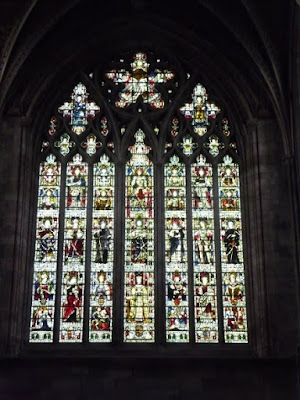
Central tower
 |
West face |
 |
Nave |
 |
West window |
 |
Ribbed vaulting |
 |
Altar and choir |
 |
Choir practice; note boys choir members in blue robes |
...recounts the retirement travels of Mark and Vicki Sherouse since 2008...in Asia and the Pacific, New Zealand, Europe, South America, and Africa, as well as the US and Canada. Our website, with much practical information, is: https://sites.google.com/site/theroadgoeseveron/.Contact us at mark.sherouse@gmail.com or vsherouse@gmail.com.

 |
West face |
 |
Nave |
 |
West window |
 |
Ribbed vaulting |
 |
Altar and choir |
 |
Choir practice; note boys choir members in blue robes |
 |
City square, Hereford |
 |
The "Old House," city square, ground zero, Hereford; part of the city museum, it is crammed with 16th and 17th century furnishings |
 |
Among the furnishings...beautifully carved |
 |
A toddler lap-walker... |
 |
16th century dog door |
 |
"The Lawsuit"--16th century humor |
 |
Stokesay castle
|
 |
Inside the great hall
|
 |
Beautiful 15th century hearth in the family quarters
|
 |
The tower
|
 |
Some residual fighting did occur, which damaged the little 11th century church,
then rebuilt in the 17th |
 |
The church is notable, we thought, for its boxed or gated
pews, including the high boxes afforded some members;
today's equivalent of "sky-boxes," I suppose
|
 |
Entrance to Powys Castle
|
 |
Virginia Creeper
|
 |
Castle from the 17th century garden
|
 |
Countryside from the garden
|
 |
Flowers, Alstroemeria Psittacine, specifically
|
 |
Hedges in the garden
|
 |
So here you are, looking down a couple hundred feet of
perfectly trimmed 8 or 10 foot high hedge, pictured above; obviously they use laser-guided trimmers |
 |
And the mountain-size topiary is not bad either
|
 |
The Victorian cog railway still plies the route; here it is in the valley, the weather, hopeful... |
 |
A couple hours later, near the summit, in the clouds; BTW, I, obviously, eschewed the train; that is to say, I eschewed-schewed. |
 |
Just below Snowdon summit |
 |
Snowdon summit compass |
 |
The Irish Sea, and beyond, the Wicklow Mountains, and far to the right, the Isle of Man... |
 |
Summit self-Portrait |
 |
Staircase into the Abyss...one of the alternative trails |
 |
Clogwyn dur Arduu...as I would like to have seen it |
 |
Caernarfon Castle from the harbor; stolen, yes |
 |
View of the fortified harbor; not stolen |
 |
Interior view |
 |
View from tower |
 |
The Triple Eagle Tower, designed to impress the Welsh; note bands of stone, which Edward would have seen on his travels to Italy, the Holy Land, etc. |
 |
Charles' Investiture (from exhibit) |
 |
Last evening's sunset from our "campsite" on the Strait of Menai |
 |
Bryn Celli Ddu, about 20 feet high, 60 feet in diameter
|
 |
The carved menhir outside
|
 |
Looking in the passage-way
|
 |
The interior menhir
|
 |
Kerbs and entry
|
 |
| Moel-y-don, on the Strait of Menai |
 |
| Druidess Vicki |
 |
| Viking ship? Roman? Welsh? |